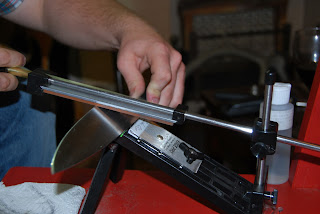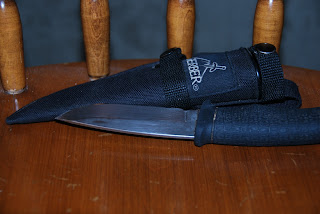The only thing to do during the transition period between open water and frozen lakes, of course, is to go fishing elsewhere. Todd (who you met in the moose hunt post) and I took a long weekend in Haines two weeks ago, looking to hit the end of the coho run on the Chilkat. The peak of things tends to be around Thanksgiving, but that also tends to be when Haines and the Chilkat are overrun with drunk Canadians flinging pixies. We hoped to avoid the crowds, but still get into fish.
 Chilkat River
Chilkat RiverThere's a lot about salmon fishing I don't know. The Chilkat is a biggish, brownish, braided river, so there's lots of water and it's tricky to read. Salmon don't really act like stream-resident fish (I don't think), and they're not feeding anyway, so you're chasing unusual fish that take some special voodoo to make bite. My understanding of coho is that they tend to hang out in slower-moving pools, and that they're most likely to bite when your fly is moving quickly and they're coaxed into chasing it. Another feature of the Chikat, that's either a blessing or a curse, depending on how you feel about it, is that it's got a healthy run of chum salmon, concurrent with coho.
We started in an upriver spot, that we'd had good reports on from a friend of a friend. It was packed with salmon, but they were all chum, and they all looked pretty much like this:
 Senescent salmon
Senescent salmonAfter a bit of scouting, we managed to spot a couple of silvery-looking fish in amongst a mass of scuzzy chum, and took turns swinging flies at specific fish. It was a pretty useful exercise - I'd stand downstream of Todd and watch the fly and the fish while he swung through the school - it gave me a better understanding of how flies swing and how fish react to them. After a bit of work, we each managed to hook the fish we were looking at, but they weren't quite as silvery as they'd looked in the water.
 May not be good to eat, but they've got great patterns
May not be good to eat, but they've got great patterns
After a few chum, we headed further downstream in search of coho (or, at least, fresher chum). We stopped for the evening at the closest run to the estuary, and got into good numbers of fresh chum, a couple of which Todd kept. They were pretty silver, but the flesh was already starting to get soft - they'll be edible, I'm sure, but I wouldn't keep any chum less fresh than these:
 An eater (depending on who you ask)
An eater (depending on who you ask)
 Bright chum
Bright chumIt's impressive how much more of a fight you get out of fresh fish - you tend to be able to call how long a fish has been in the river before you can even see it, by how much line it's taking. These silver chum fought pretty well.
The next day was rainy, cold and windy as hell. Out in the main river flats, casting even with my 8/9 switch was useless. Back at the downstream run we'd worked the night before, we concentrated on little troughs of slow current close to shore, in the lee of shoreline forest. Almost right away, I got into a fish that took line so fast I skinned my knuckles on the reel handle while trying to get hold of it. After a great fight - success, a bright coho buck.
 Kisutch!
Kisutch!Almost immediately afterward, I hooked and landed a slightly darker jack coho, and Todd snagged a big bright hen in the tail. Much consternation at having missed the opportunity to fairly hook (and consequently, keep) this fish.
 Todd is less pleased than he looks
Todd is less pleased than he looks
After that, nothing more on the coho front. I suspect it was a small pulse of fresh fish in from the salt, from which we picked off a few as they passed by. The two that I caught certainly kept to the coho wisdom I'd been given - they were in slow water, and hit a (big pink) fly as I was actively stripping it in. I've got a good recipe for coho flies, by the way, which I'm looking to modify for steelhead use - they look incredible when they're swimming, and they swing really nicely (and nearly every fish we caught the first two days was on the pink version). Another post.
The last day, we slowly worked our way upriver as we headed toward the pass and Yukon. Well upriver, we found a clear pool packed with coho and Dolly Varden, which were too irresistable to pass up (despite being pretty dark). Fish like this are fun to look at, but not to eat - after catching a few, we left them be. I tried, and failed, to catch one of the (really quite big) Dollies.
 More where this one came from
More where this one came from
Overall, a good trip, though I'd try earlier next year to catch the bulk of the run. The river was deserted while we were there, I could probably put up with a few more people for a few more fish.
So, what to do with a bright Chilkat coho?
Salmon head soup!
 I need to clean my counter
I need to clean my counter
This is really good.
 Shiny new pot, full of a burbot
Shiny new pot, full of a burbot If this were eXistenZ, I could turn this into a gun
If this were eXistenZ, I could turn this into a gun Less meat here than you might expect
Less meat here than you might expect




















